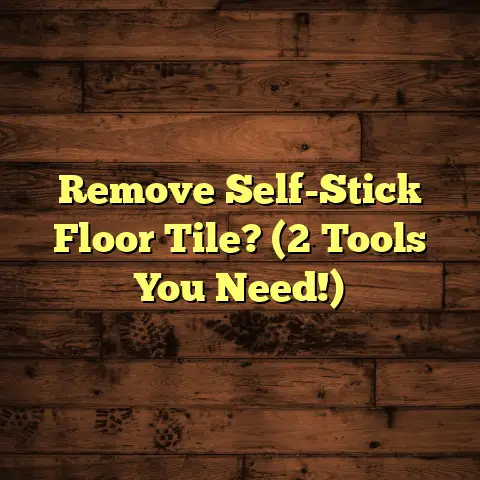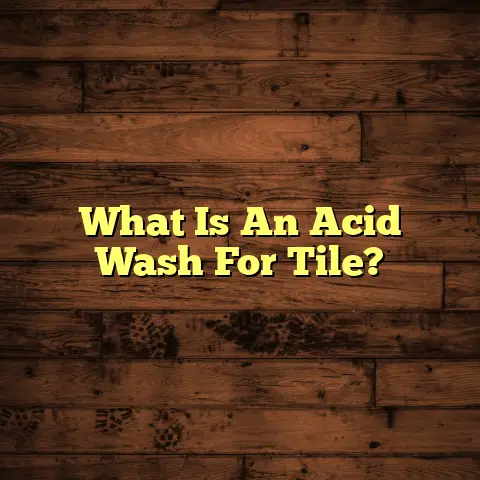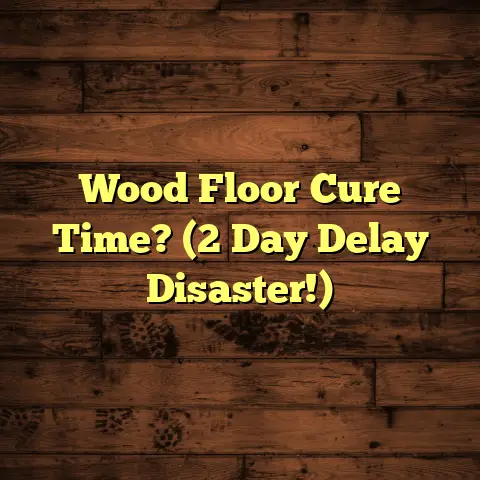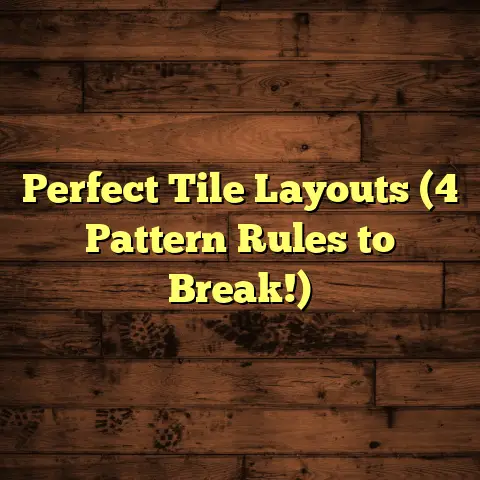Fix Peeling Wood Floors? (4 Steps To Restore!)
They can actually impact the air quality in your home, especially if you’re someone who deals with allergies.
Think about it: those cracks and
peeled areas become perfect little
hideouts for dust mites, mold spores,
and even pet dander.
Not fun, right?
As a flooring contractor, I’ve seen my fair share of peeling floors, and I’m here to tell you it’s fixable.
Let’s dive into why this happens and, more importantly, how you can restore your floors to their former glory.
Section 1: Understanding Peeling Wood Floors
So, what exactly are we talking about when we say “peeling wood floors”?
It’s when the finish – that protective layer on top of the wood – starts to flake off, chip, or peel away.
This isn’t just a cosmetic issue; it’s a sign that something’s not quite right.
Common Causes of Peeling
- Moisture: This is the big one. Wood expands and contracts with moisture changes. Too much humidity or a water leak can wreak havoc.
- According to the EPA, indoor humidity should ideally be between 30-50% to prevent mold growth and wood damage.
- According to the EPA, indoor humidity should ideally be between 30-50% to prevent mold growth and wood damage.
- Improper Installation: If the floors weren’t installed correctly to begin with, peeling is more likely. Things like inadequate subfloor preparation can cause problems down the line.
- Lack of Maintenance: Neglecting your floors can lead to finish breakdown. Regular cleaning and occasional refinishing are key.
- Wrong Products: Using harsh cleaning chemicals or the wrong type of finish can damage the wood and cause peeling.
- Old Age: Let’s face it, nothing lasts forever. Over time, the finish simply wears down.
Types of Finishes and Degradation
There are two main types of finishes I typically work with:
- Oil-Based Finishes: These provide a durable, classic look. They tend to yellow over time and can be more prone to cracking if not properly maintained.
- Water-Based Finishes: These are more eco-friendly and dry faster. They’re generally more flexible, but may not be as hard-wearing as oil-based options.
When these finishes degrade, they lose their protective qualities, making the wood vulnerable to moisture and wear.
Signs of Peeling
- Visible Peeling: Obvious flakes or chips on the surface.
- Discoloration: Dark patches or uneven coloring where the finish has worn away.
- Rough Texture: The floor feels coarse or uneven to the touch.
- White Spots: Can indicate moisture trapped under the finish.
Impact on Home and Health
Peeling floors not only look bad, but
they can also affect your home’s
structural integrity.
The exposed wood
is more susceptible to damage.
And, as I mentioned earlier, peeling creates a haven for allergens.
According to the American Lung Association, maintaining clean floors is crucial for reducing indoor allergens and improving air quality.
Section 2: Assessing the Damage
Alright, so you’ve noticed some
peeling.
Now what?
It’s time to play
detective and figure out how bad the
damage really is.
Assessing the Extent of the Peeling
- Superficial vs. Deep: Is the peeling just on the surface, or does it go deeper into the wood? Superficial damage is usually easier to fix.
- Area Affected: Is it just a small patch, or is the peeling widespread? This will determine the scope of the project.
- Underlying Issues: Are there any signs of water damage, mold, or insect infestation? These need to be addressed before you even think about refinishing.
Tools and Materials for Assessment
Here are a few tools I always have on hand when assessing floor damage:
- Moisture Meter: This is a must-have for checking moisture levels in the wood and subfloor. I recommend one that gives you both surface and penetration readings.
- Scraper: For gently removing loose finish to get a better look at the wood underneath.
- Magnifying Glass: To inspect for fine cracks, mold, or insect damage.
- Flashlight: Helps you spot discoloration and unevenness.
- Camera: Take photos to document the damage.
This can be helpful for insurance claims or when consulting with a professional.
Checking for Water Damage or Mold
Water damage and mold are serious issues
that need to be addressed immediately.
Here’s what to look for:
- Musty Odor: A telltale sign of mold.
- Dark Stains: On the wood or subfloor.
- Soft Spots: The floor feels spongy or gives way when you step on it.
- Visible Mold: Look for fuzzy or discolored patches.
If you suspect water damage or mold, it’s crucial to call in a professional for remediation.
DIY vs. Professional
So, can you tackle this yourself, or do
you need to call in the pros?
Here’s my
rule of thumb:
DIY:
- Small areas of superficial peeling
- No signs of water damage or mold
- You’re comfortable with sanding and
refinishing
Professional:
- Widespread peeling
- Signs of water damage, mold, or insect infestation
- You’re not comfortable with DIY projects
- You want a guaranteed result
Section 3: The 4 Steps to Restore Peeling Wood Floors
Okay, let’s get down to business.
Here
are the four steps I use to restore
peeling wood floors.
Step 1: Prepare the Area
Preparation is key to a successful restoration.
- Clear the Area: Remove all furniture, rugs, and anything else that might get in the way. This is a good time to give the room a thorough cleaning.
- Ventilation: Open windows and doors to ensure proper ventilation. If possible, use a fan to circulate the air.
- Safety: Wear a dust mask, safety glasses, and gloves to protect yourself from dust and chemicals.
- Protect Surroundings: Cover adjacent areas with plastic sheeting to prevent dust and finish from spreading.
Tools and Materials:
- Drop cloths or plastic sheeting
- Painter’s tape
- Dust mask, safety glasses, and gloves
- Vacuum cleaner
- Cleaning supplies
Step 2: Repair the Damage
Now it’s time to get rid of that peeling finish and smooth out any imperfections.
- Remove Loose Finish: Use a scraper or putty knife to gently remove any loose or flaking finish. Be careful not to gouge the wood.
- Sanding: This is where the real work begins.
- Start with Coarse Grit: Use 60-80 grit sandpaper to remove the old finish and smooth out any rough spots.
- Move to Medium Grit: Switch to 100-120 grit sandpaper to further refine the surface.
- Finish with Fine Grit: Use 150-180 grit sandpaper for a smooth, even surface.
- Start with Coarse Grit: Use 60-80 grit sandpaper to remove the old finish and smooth out any rough spots.
- Patching: For deeper scratches or gouges, use wood filler.
- Apply Wood Filler: Fill the damaged area with wood filler, making sure to overfill slightly.
- Let it Dry: Allow the wood filler to dry completely according to the manufacturer’s instructions.
- Sand Smooth: Sand the filled area smooth with fine-grit sandpaper, blending it into the surrounding wood.
- Apply Wood Filler: Fill the damaged area with wood filler, making sure to overfill slightly.
- Vacuum: Thoroughly vacuum the entire area to remove all dust and debris. Follow with a tack cloth to pick up any remaining particles.
Step 3: Refinish the Floors
Time to bring back the shine!
- Choose the Right Finish:
- Oil-Based: Durable, classic look, but can yellow over time.
- Water-Based: Eco-friendly, dries faster, but may not be as durable.
- Polyurethane: A popular choice for its durability and water resistance.
- Oil-Based: Durable, classic look, but can yellow over time.
- Application:
- Apply Thin Coats: Use a brush, roller, or applicator pad to apply a thin, even coat of finish. Avoid pooling or drips.
- Follow the Grain: Always apply the finish in the direction of the wood grain.
- Avoid Bubbles: If you see bubbles, gently brush them out.
- Apply Thin Coats: Use a brush, roller, or applicator pad to apply a thin, even coat of finish. Avoid pooling or drips.
- Drying Time: Allow the finish to dry completely according to the manufacturer’s instructions. This usually takes several hours.
- Multiple Coats: Apply at least two coats of finish, sanding lightly between coats with fine-grit sandpaper. This will ensure a durable, even finish.
Step 4: Maintain Your Restored Floors
Prevention is better than cure, right?
- Humidity Control: Maintain a consistent humidity level in your home to prevent wood from expanding and contracting. Use a dehumidifier or humidifier as needed.
- Regular Cleaning: Sweep or vacuum your floors regularly to remove dirt and debris. Use a damp mop with a mild cleaning solution specifically designed for wood floors.
- Avoid Harsh Chemicals: Don’t use abrasive cleaners, bleach, or ammonia, as these can damage the finish.
- Use Rugs and Mats: Place rugs and mats in high-traffic areas to protect the floors from wear and tear.
- Periodic Inspections: Check your floors regularly for signs of wear or damage. Address any issues promptly to prevent them from getting worse.
- Touch-Ups: Apply a fresh coat of finish to high-traffic areas every few years to maintain the protective layer.
Section 4: Frequently Asked Questions
Let’s tackle some common questions I get asked all the time.
Q: How can I prevent peeling in the future?
A: The biggest thing is controlling
humidity.
Also, use the right cleaning
products and avoid excessive water.
Q: Is it possible to refinish wood floors multiple times?
A: Yes, but there’s a limit.
Solid wood
floors can be sanded and refinished
several times.
Engineered wood floors
have a thinner layer of real wood, so
they can usually only be refinished once
or twice.
Q: What should I do if I find mold under my wood floors?
A: Stop everything and call a
professional mold remediation company.
Mold can be a serious health hazard, and
it needs to be addressed properly.
Q: Can I just paint over peeling wood floors?
A: While you can, I wouldn’t recommend
it.
Paint won’t adhere well to a peeling
surface, and it won’t address any
underlying issues.
It’s a temporary fix
at best.
Q: How often should I clean my wood floors?
A: Sweep or vacuum at least once a week,
and damp mop every 1-2 weeks.
Adjust
based on foot traffic and how dirty the
floors get.
Q: What’s the best type of finish for high-traffic areas?
A: Polyurethane is a great option for high-traffic areas because it’s very durable and water-resistant.
Conclusion
Peeling wood floors might seem like a major headache, but with a little knowledge and effort, you can restore them to their former glory.
Remember those four steps: prepare, repair, refinish, and maintain.
By addressing peeling promptly, you’re not only improving the look of your home but also creating a healthier living environment for you and your family.
So, grab your tools, roll up your
sleeves, and get to work!
Your floors
(and your allergies) will thank you.





